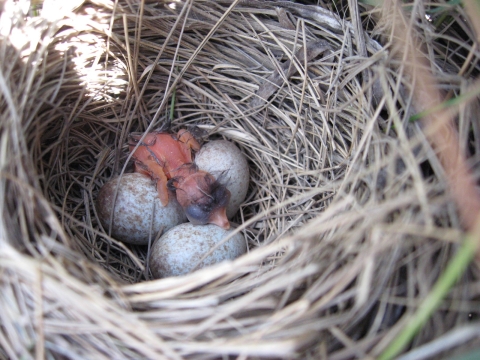Along the Atlantic Coast, a quiet, small sparrow blends in with the grasses of the salt marsh salt marsh
Salt marshes are found in tidal areas near the coast, where freshwater mixes with saltwater.
Learn more about salt marsh while it feeds on insects and gathers food to bring back to its nest.
The saltmarsh sparrow, inhabiting only tidal salt marshes, has rust-colored wings, a vivid orange-buff face, and gray plumage with black stripes.
This bird of the coast is unique to the eastern U.S. — it’s the only place saltmarsh sparrows are found in the world! Here at the Long Island Field Office, saltmarsh sparrows are located right in our backyard, at the Wertheim National Wildlife Refuge. Throughout Long Island’s tidal salt marshes, these birds make their nests in hidden areas of grass that blend in with the surroundings.
Life isn’t easy for the saltmarsh sparrow. They are threatened by tidal flooding that can infiltrate their nest and endanger their eggs and young. Nesting in a shallow site will attract the attention of predators. Deeper sites will pose the risk of high tide flooding the nest, drowning chicks or flushing eggs. While the birds were adapted to typical floods during monthly lunar tides and storm events, they are not adapted to increased flooding from rising seas and more frequent storms. By 2050, the sea is expected to rise 13 to 18 inches across the sparrow’s range.
These aren’t the only pressures these birds face in the saltmarsh. Roads, buildings, beachside homes and other development greatly reduce the natural habitat that the saltmarsh sparrows rely on for survival.
These birds are declining at an alarming rate from the effects of sea level rise and loss of habitat. Scientists estimate that four out of every five saltmarsh sparrows may have already disappeared. Without the necessary conservation efforts, the saltmarsh sparrow population could collapse within 50 years, according to the Saltmarsh Habitat and Avian Research Program (SHARP).
Fortunately, this bird has a lot of people looking out for it.
Here at the Long Island Field Office, I teamed up with the Wertheim National Wildlife Refuge Staff to assist in vegetation surveys for their salt marsh restoration and enhancement project. This project was implemented by the U.S. Fish and Wildlife Service to restore degraded salt marshes on Long Island in response to the damage from Hurricane Sandy in 2012. Healthy coastal marshes not only provide wildlife habitat, but they protect the coast from flooding, provide clean water, and support multi-billion dollar fishery and tourism industries.
The three project sites are at Wertheim National Wildlife Refuge, Seatuck National Wildlife Refuge, and Lido Beach Wildlife Management Area.
We trekked out into the marsh and surveyed different plots to obtain plant counts and plant heights, water salinity levels, and percent coverage of the plot area. As we trudged through the saltmarsh, my boots sank deeper and deeper into the mud and we fought our way through tall phragmites and armies of mosquitos. The tough terrain led to beautiful open areas of the salt marshes, where the atmosphere was peaceful and serene. Although we didn’t see any saltmarsh sparrows, we were able to experience their natural habitat and see how these areas are essential to the species that depend on Long Island salt marshes.
Tracking the changes in vegetation is a vital part of restoring salt marsh, so we can determine how the ecosystem is being affected by these changes. When rising seas change high marsh to low marsh, it is no longer able to support saltmarsh sparrows or other species like black rail.
Restoring the salt marshes on Long Island will improve habitat for the saltmarsh sparrow. By increasing defenses to large storms and reducing long-term vulnerability to sea level rise, the saltmarsh sparrows will have a greater chance at surviving and recovering as a population. There will be more space for the sparrow to nest on safer ground without concern for high tides infiltrating their nests.
As the tides continue to change, the uncertainties in the saltmarsh sparrow’s future remain steady. With the continued efforts of restoring and enhancing salt marsh habitat, there is hope for saltmarsh sparrows to successfully nest and restore population numbers in tidal salt marshes.
The U.S. Fish and Wildlife Service has been engaged in saltmarsh sparrow conservation for more than a decade. In coordination with the Atlantic Coast Joint Venture (ACJV), a state-federal-NGO-academic partnership that works across the sparrow’s range, we are planning and implementing substantial and innovative work to conserve saltmarsh sparrows and coastal marshes, as well as seeking new partners and investments for that work. Learn more at https://acjv.org/saltmarsh-sparrow-2/.






